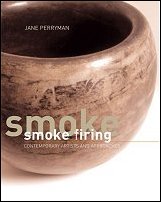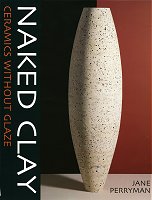
SMOKE FIRING CONTEMPORARY ARTISTS AND APPROACHES
Published 2008 A&C Black,University of Pennsylvania Press, La Revue de la Ceramique and Haupt. ISBN 978-0-7136-6985-5
'Smoke Firing is an ancient firing method, used to both fire raw clay into durable ceramic and also to decorate it with smoke designs. Its technological simplicity not only lends itself to endless interpretations but also encourages artistic creativity through improvisation and experimentation. Smoke Firing is a thorough survey of the varied work and approaches of contemporary artists today, showing recent innovative developments. By investigating the ideas of selected ceramists Jane Perryman reveals the meanings and inspiration behind their work. Clear and colourful images demonstrate the various processes used, showing sequences of artists in action. The book covers smoke firing using bonfires, various containers, earth pits, saggars and kilns, with a chapter on how smoke firing can be used as an educational tool within groups and workshops. Dynamic illustrations feature the work of 29 artists represented from 17 different countries, making it a truly international focus on smoke firing.'
Price £30
purchase 'Smoke Firing' from Amazon Books or acblack.com
see review below
NAKED CLAY - CERAMICS WITHOUT GLAZE
Published 2004 A&C Black
ISBN 978-0-7136-6985-5
 'A growing number of ceramic artists now choose not to glaze their work. Instead they use an unglazed - naked - surface to achieve their design objectives. From slips and terra sigillata to burnishing, engobes, oxide washes and additions to the clay body, there is a wide range of techniques these artists employ to achieve desirable finishes. As these techniques are suitable for a broad spectrum of processes, subject matter and context (from slip casting to hand building, from high to low firing temperatures, from figurative to conceptual, from domestic to public), the scope of the work produced by these artists is enormous.
In 'Naked Clay' Jane Perryman not only presents the finished ceramics and techniques of an international group of artists but also investigates their ideas and areas of inspiration to further an understanding of their work. Each artist presented here has a unique style and way of working , but they are all connected through their committed relationship to the material and their desire to express their ideas using 'naked clay'.
'A growing number of ceramic artists now choose not to glaze their work. Instead they use an unglazed - naked - surface to achieve their design objectives. From slips and terra sigillata to burnishing, engobes, oxide washes and additions to the clay body, there is a wide range of techniques these artists employ to achieve desirable finishes. As these techniques are suitable for a broad spectrum of processes, subject matter and context (from slip casting to hand building, from high to low firing temperatures, from figurative to conceptual, from domestic to public), the scope of the work produced by these artists is enormous.
In 'Naked Clay' Jane Perryman not only presents the finished ceramics and techniques of an international group of artists but also investigates their ideas and areas of inspiration to further an understanding of their work. Each artist presented here has a unique style and way of working , but they are all connected through their committed relationship to the material and their desire to express their ideas using 'naked clay'.
This beautifully illustrated book will not only inform and inspire students, professionals and teachers, but it will also fascinate collectors and indeed anyone with an interest in contemporary ceramics.
price : £30
ISBN 0-7136-5309-4
purchase 'Naked Clay' from Amazon Books or acblack.com
see review below
TRADITIONAL POTTERY OF INDIA
Published 2000 by A&C Black
 Pottery has a long history in India. Over the centuries, it has been used for domestic ware, votive pieces and for architecture, and each area of the country is known for its different styles. In this book, Jane Perryman not only looks at Indian pottery but also at the communities who make it, their organisation, history and philosophy.
Pottery has a long history in India. Over the centuries, it has been used for domestic ware, votive pieces and for architecture, and each area of the country is known for its different styles. In this book, Jane Perryman not only looks at Indian pottery but also at the communities who make it, their organisation, history and philosophy.
Traditional Pottery of India encompasses the diversity and beauty of India itself and most particularly the stunning pottery that is made there.
With glorious photographs of the Indian landscape and diverse pottery communities, this book should appeal not only to potters but also to students of other cultures and, indeed, anyone interested in India as a whole.
price : £35
ISBN 0-7136-4521-0
purchase 'Traditional Pottery of India' from Amazon Books or acblack.com
see review below
SMOKE FIRED POTTERY
Published 1995 by A&C Black
 In this book Jane Perryman discusses a wide range of smoke firing methods. She uses the work of an international group of artists as well as that of traditional potters from Nigeria, India and the South West United States to illustrate the methods and to show the various qualities that can be achieved with smoke firing. She also discusses the possibilities of using this method with children of all ages.
In this book Jane Perryman discusses a wide range of smoke firing methods. She uses the work of an international group of artists as well as that of traditional potters from Nigeria, India and the South West United States to illustrate the methods and to show the various qualities that can be achieved with smoke firing. She also discusses the possibilities of using this method with children of all ages.
The simplicity and comparative inexpensiveness of smoke firing make it particularly suitable for use in schools.
Smoke Fired Pottery has been designed as an introduction and practical handbook to the subject. It is also intended as a inspiration for other potters and a source of delight for all those interested in ceramics.
price : £35
ISBN 0-7136-3882-6
NOW OUT OF PRINT
see review below
selected Published Articles
2009 - New Ceramics (Germany) - feature article 'Smoke Fired Pottery'
2006 – Ceramics Technical no 22 feature article
2005 - The Studio Potter (USA) Volume 33 feature article
2005 - La Revue de la Ceramique et du Verre no. 142 May/June
2005 - New Ceramics / Neue Keramik May/June
2004 - Neue Keramik (Germany) - feature article 'Jane Perryman'
2003 - Now Showing - Exhibition preview article in Ceramic Review no. 201
2002 - Form Pattern and Smoke - feature article in Ceramics Monthly (January edition)
2000 - Traditional Pottery of India - A & C Black (see review below)
2000 - Rites of Passage - article in Ceramic Review No.183
2000 - A Research Journey in India - article in Ceramics Technical No.10 (Australia)
1999 - A Homage to Indian Potters - article in Neue Keramik (Germany)
1996 - Houses on Fire article in Ceramic Review No.162
1996 - Smoke Fired Pottery - article in April issue of Ceramics Monthly (USA)
1995 - Smoke Fired Pottery - A & C Black (see Review)
1993 - Bodies, Vessels and Imagination - article in Ceramic Review No.141
selected Publications featured in:
2008 - Surface Design for Ceramics by Maureen Mills (Lark Books)
2007 'Firing; Philosophies within Contemporary Ceramic Practice' by David Jones Crowood
2006 'Coiling' by Michael Hardy (A&C Black)
2004 - 'Alternative Kilns and Firing Techniques' by James C Watkins & Paul Andrew Wandless (Lark Books New York)
2003 - Revised Edition 'Coiled Pottery' by Betty Blandino (A&C Black)
2003 - 500 Bowls - Contemporary Explorations of a Timeless Design - edited by Suzanne J.E. Tourtillot (Lark Books)
2002 - Experience Clay by Maureen Mackay (Davis Publications)
2001 - The Studio Potter Magazine USA - feature article
2001 - 'Barrel Pit & Saggar Firing' edited by Sumi von Dassow (Ceramics Monthly publishing)
2000 - Women and Ceramics - Gendered Vessels by Moira Vincentelli (Manchester University Press)
2000 - Contemporary Ceramics by Susan Peterson (Laurence King / Thames & Hudson)
2000 - The Art of Handbuilt Ceramics by Susan Bruce (The Crowood Press)
1999 - The Complete Practical Potter by Josie Warshaw (Anness Publishing)
1999 - Ceramics Monthly (March edition)
1998 - Ceramica No.65 (Spanish)
1998 - The Potter's Directory of Shape and Form by Neal French (Quarto)
1997 - Handbuilt Ceramics by Cathy Triplett (Lark Books, Altamont Press)
1996 - Coiled Pottery by Betty Blandino (A & C Black)
1994 - Second Shift No.4 (magazine about women and the arts)
1994 - Raku by Tim Andrews (A & C Black)
1994 - Sawdust Firing by Karen Hessenburg (Batsford)
Smoke Firing: Contemporary Artists and Approaches
Review by Peter Lane Ceramic Review no. 232
'Some remarkable ceramics have been produced using the most basic methods by many different cultures around the world ever since the benefits and possibilities of fired clay were first discovered. Specially designed kilns were unnecessary for many of these, because sufficient heat generated in a simple, carefully managed bonfire will transform clay into a ceramic state. more
Modern potters who choose to work with such techniques today do so because they can achieve distinctive surface tones and patterns by manipulating the passage and intensity of smoke to impregnate their works. An extremely high level of sophistication is possible both in design and execution of smoke-fired ceramics, as can be seen and admired among the many inspirational pieces chosen by Jane Perryman to illustrate this new book. She has followed a sound educational format throughout and provides an ideal introduction to smoke firing from historical aspects to the present day. Various firing processes are clearly explained while encouraging continuous experiment with materials and different kinds of fuel in order to discover the widest possible range of effects.
About eighty percent of the book is devoted to a series of excellent folios demonstrating the work, style and personal approaches of twenty nine international ceramists. The thoughts, comments and ideas of these individual artists, together with detailed descriptions of their methods and technical notes is enough to motivate any practising potter, whether student or skilled professional.
Perryman’s considerable experience in teaching groups and running workshops using minimal equipment, often salvaged from the local dump, gives extra credence to the practice and value of smoke firing, which she promotes with such obvious enthusiasm. She suggests that there are endless opportunities for improvisation. This book is an exceptional and entertaining read and a useful reference source for all students of ceramics'.
Peter Lane
less